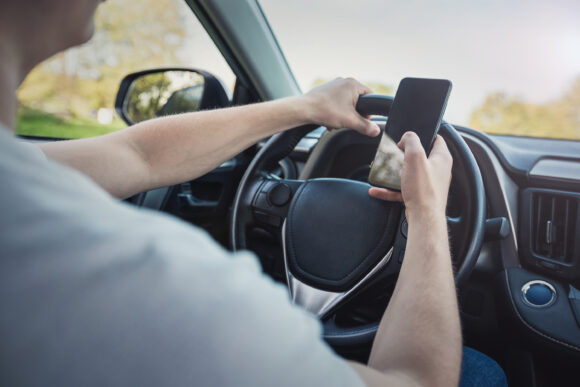US motorists are more distracted than ever while driving, interacting with their smartphones or other devices during 58% of trips taken, according to a report by Cambridge Mobile Telematics.
CMT, which supplies telematics technology that carriers use to monitor drivers enrolled in usage-based insurance programs, said the share of screen interactions per trip increased from 54% in 2020, a nearly 8% jump.
Even more concerning: Screen interaction time during trips, meaning the amount of time that devices were being used while driving, increased to two minutes and 12 seconds in 2022, up 23% from 1 minute 47 seconds in 2020. Drivers who interact with their phone screens while driving are 240% more likely to crash than drivers that don’t interact with their screens, the CMT report says.
CMT draws data from its DriveWell platform, a telematics program that is used by 21 of the top 25 US insurers. The company has issued annual reports on the insights it has gained about distracted driving since 2019.
The report cites several statistics that show a correlation between smart phone use and motor vehicle crashes.
Cycling deaths followed the same trend, with 985 fatalities in 2020, the highest number since 1990. According to the National Highway Traffic Safety Administration, 42,915 people were killed on US roadways in 2021, the largest death toll in 16 years.
When the iPhone was introduced in 2007, 4,600 pedestrians were killed on US roadways. In 2017, with smart phones now used by 77% of households, more than 6,000 pedestrians were killed, a 30% increase.
The report says the Virginia Tech Transportation Institute found that sending or receiving a text message takes a driver’s eyes off the road for an average of 4.6 seconds, which is the amount of time to travel 100 yards at 55 mph.
CMT says its own research had found that the most distracted drivers are 2.4 times more likely to crash than the least distracted drivers. A 10% increase in distracted driving would increase the crash rate by 1.4% — the equivalent of 168,000 crashes and 420 fatalities.
But distracted driving is increasing, not decreasing. In 2020, drivers handled their phones for 1 minute and 26 seconds every hour on the road. That increased to one minute 36 seconds in 2021 and one minute 44 seconds in 2022.
CMT said 34% of trips included some phone motion in 2022, up from 34% in 2020. The report says 34% of that phone motion occurred while the vehicle was traveling above 50 mph.
The CMT says one form or driver distraction, handheld cell phone calls, has decreased over time as the states adopted laws outlawing the practice. Handheld call duration dropped to 25 seconds in 2022 from 31 seconds in 2020. The percentage of trips with handheld calls also dropped, falling to 3.6% of trips in 2022 from 3.9% in 2020.
CMT said 35 states now have ban cellphone use while driving. Distracted driving is far less common in states that bar the practice.
CMT said Louisiana had the highest rate of screen interaction: 68% of trips, followed by Mississippi (65%), Alabama, (63%) and South Carolina, (63%), Oklahoma (62%) and Georgia, (61%).Mississippi, Alabama, and South Carolina don’t have hands-free laws, the report says, while the laws in Louisiana and Oklahoma are weak.
CMT said average screen interaction time plummets the week after a state enacts a law banning handheld use of devices while driving, but often increases later. Phone motion dropped an average of 16% in the week after a handheld ban took effect. But the data shows screen interaction often starts rising again after the novelty of a new ban wears off. Georgia, Tennessee, Minnesota and Virginia showed more phone motion per hour in late 2022 than when handheld bans were initially adopted.
Drivers who monitor their driving habits also tend to reduce the amount time they are distracted. CMT said a study it conducted with a major insurer of distracted driving awareness. Some drivers in the study were given standard risk scores based on braking, speeding and acceleration. A second group also received a distraction score. The study found that drivers who received a distraction score were 25% less distracted than drivers who received only the standard score.
Similarly, drivers who engage with their telematics program by checking their driving performance scores tended to be less distracted while driving. CMT said after one month of monitored driving, “unengaged” drivers were distracted an average of one minute 41 seconds per hour . Engaged drivers, meaning those that checked the usage-based app 20 or more times each month, were distracted for an average of 29 seconds per hour, the report says.
Engaged drivers got better over time. Those that remained engaged over a three-month period were distracted an average of only 23 seconds per hour, the report says.
Was this article valuable?
Here are more articles you may enjoy.


 Waymo to Update Software Across Fleet After Major Power Failure
Waymo to Update Software Across Fleet After Major Power Failure  Trump Sues BBC for $10 Billion Over Documentary Edit
Trump Sues BBC for $10 Billion Over Documentary Edit  Twice Injured Firefighter Loses Second Workers’ Compensation Claim
Twice Injured Firefighter Loses Second Workers’ Compensation Claim  Jump Trading Faces $4 Billion Terraform Administrator Suit
Jump Trading Faces $4 Billion Terraform Administrator Suit 